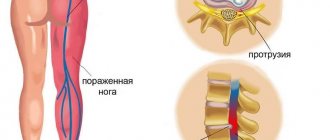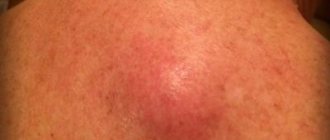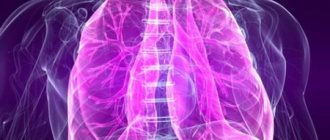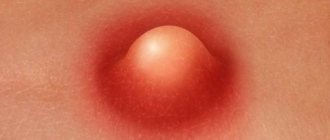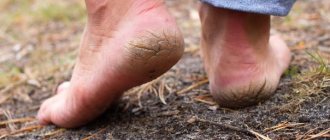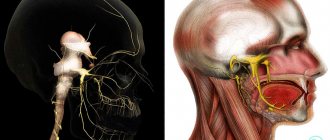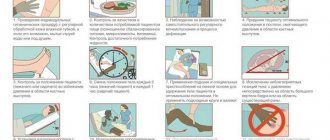Inflammation of the sciatic nerve, nervus ischiadicus, is called sciatica. This nerve innervates the muscles of the thigh, calf and foot - the extensor pollicis longus, the extensor digitorum longus and the plantar surface of the 1st to 4th toes. Pain in the sciatic nerve with sciatica occurs as a result of its pinching and inflammation.
The sciatic nerve arises from the sciatic plexus. In the middle of the thigh it is divided into the tibia and fibula. Next – goes to the sole.
Description
Sciatica is a condition characterized by pain due to irritation or compression of the sciatic nerve.
Most often, sciatica develops in people of working age after 40 years of age; very rarely, this problem concerns people under 30 years of age. Factors that compress the sciatic nerve include any inflammatory processes at the site of its passage, starting from the place where it exits the spinal canal. Lesions of the lumbar and sacral spine, pelvis and legs can provoke the development of nerve pathology. These include:
- intervertebral hernia of the lumbar spine;
- infectious-toxic effects of certain microbial agents: pathogens of tuberculosis, malaria, syphilis, scarlet fever, typhoid and influenza;
- toxic effects of alcohol, heavy metal salts, arsenic;
- metabolic disorders in diabetes and gout;
- local bone growths (osteophytes) in the area of the lumbar and sacral vertebrae and osteoarthritis;
- widespread osteochondrosis of the spine;
- vertebral spondylosis;
- the presence of hematomas or fibrous cords at the exit site of the sciatic nerve roots;
- osteoma, chondrosarcoma and other oncological diseases or metastases with localization of the lesion at the exit site of the sciatic nerve trunk;
- deformation or displacement of the vertebrae in the lumbosacral region;
- scoliosis;
- congenital pathology of the musculoskeletal system;
- traumatic injuries of the spine;
- sciatica in children with juvenile rheumatoid arthritis;
- sciatica in women during pregnancy due to physiological displacement of the pelvic bones.
Pathology of the sciatic nerve most often affects the motor functions of the limb on the affected side. Decreased sensitivity and stiffness in the knee and ankle joints may occur (due to severe muscle weakness). With a pronounced pathological process, paresis and paralysis on the affected side may be observed. In addition, the functioning of internal organs - the intestines and bladder - may be disrupted. As a result, a person develops urinary and fecal incontinence.
Symptoms
Photo: estet-portal.com
The main manifestation of sciatica is pain, which significantly reduces the patient’s quality of life. Initially, pain appears in the lumbar spine, but as the process progresses, the patient notes the appearance of pain radiating to the right or left leg (it is extremely rare to detect irradiation to both legs). The pain spreads down the leg - to the back of the thigh, into the popliteal fossa and down the back of the leg, in some cases the pain reaches the foot and fingertips. The nature of the pain is varied, it can be as follows:
- burning;
- aching;
- piercing;
- blunt;
- acute;
- shooting;
- raw.
Sciatica pain can be either chronic or intermittent, depending on the cause of the disease. In most cases, the pain radiates from the lumbar region along the entire back of the leg, but in rare cases the patient notes the appearance of pain only in a separate part of the leg. The degree of pain intensity differs. In some cases, the pain syndrome is mild, which has little effect on the person’s condition. It’s another matter if a person has severe pain that significantly affects the person’s life.
In addition to the main symptom of sciatica - pain, a person may be bothered by paresthesia. This definition denotes one of the types of sensitivity disorder, characterized by the appearance of a tingling, burning sensation, or “crawling goosebumps” on the skin. The patient may also be bothered by numbness of the limbs, decreased sensitivity, and slight swelling. In rare cases, there are complaints of redness of the skin, lack of sweating, or, conversely, extreme sweating.
How to sleep with sciatica
During the pathology, severe pain occurs, especially with movement or compression. Therefore, the patient becomes uncomfortable sleeping, he constantly wakes up due to the onset of pain. Doctors recommend drug therapy before bedtime to get enough sleep during an exacerbation of the disease:
- Ketorolac
injections no more than 1 ml for 3 days; - use Omeprazole
1 tablet per day to reduce the load on the stomach.
If the exacerbation is prolonged, it is not recommended to drink or inject the medicine every day. To sleep with sciatica of the sciatic nerve, you need to take a comfortable position in your sleep; you can only lie on your side. An orthopedic mattress is used to reduce the load on the musculoskeletal system. Exercises are performed in bed:
- from a position lying on its side, the upper leg is bent at the knee, the body is turned in the other direction (alternately in both directions);
- from a supine position, bend your knees and pull them towards your chest;
- legs hanging from the bed, alternately tightening the chest, first the left, then the right limb.
Exercises are done before bedtime. They can be performed if the patient feels pain at night. They relieve tension and reduce stress on the nerve.
Diagnostics
Photo: simptomy.ru
A neurologist diagnoses sciatica, so if you have lower back pain radiating to your leg, you need to contact this specialist. During a conversation with the patient, the neurologist establishes the nature of the pain, its duration, time of occurrence, as well as factors contributing to the onset of pain. Next, the doctor checks the patient for some symptoms, the appearance of which is caused by tension in the roots of the spinal nerves, the nerves themselves, or the surrounding tissue. These include:
- Sicard's symptom (pain in the popliteal fossa when flexing or extending the foot);
- Lasegue's symptom (bending the straightened leg at the hip joint causes pain in the lumbar region and on the back of the thigh and lower leg. Bending the leg at the knee joint eliminates the pain).
Instrumental diagnostic methods for sciatica include X-ray examinations, ultrasound, CT and MRI. With their help, it is possible to determine the degree of pinching of the spinal nerve roots, as well as to assess the prevalence of the inflammatory process. An X-ray of the lumbar spine is not highly informative, since this study only helps to establish spondylosis, which, in turn, can lead to the development of sciatica. Otherwise, X-ray examination is prescribed as a differential diagnosis of sciatica with diseases of other types. Ultrasound examination (ultrasound) allows you to visualize the structure of soft tissues (tendons, ligaments, cartilage, etc.), including identifying the presence of a neoplasm, which requires an immediate solution to the problem. This research method has a number of advantages:
- no contraindications;
- the possibility of repeated use of ultrasound throughout the course of treatment;
- fairly good visualization of soft tissues.
The most informative are CT (computed tomography) and MRI (magnetic resonance imaging). Preference is given to MRI, since currently this study is considered the most effective, since it allows you to visualize not only bone structures, but also soft tissues. Despite many advantages, MRI has a number of contraindications:
- the presence in the body of a medical device made of metal, including an artificial pacemaker;
- the presence of any non-medical metal objects in the body;
- claustrophobia (fear of closed spaces);
- epilepsy;
- pregnancy.
The study does not require any preliminary preparation, including no restrictions on food intake.
If the patient has a sensitivity disorder, ENMG (electroneuromyography) is prescribed to determine the state of the peripheral nervous system. The study evaluates the speed of nerve impulse transmission along nerve fibers.
With mild or moderate pain, the patient may not seek help from a specialist for quite a long time, since their condition has little impact on everyday life. However, sudden attacks of pain should alert a person, since their appearance may indicate not only a pinched nerve, but also more serious problems, such as the presence of a tumor. That is why it is recommended to immediately consult a doctor when the first symptoms of the disease appear and in no case neglect your condition. A qualified doctor will not only make an accurate diagnosis, but will also suggest the most effective ways to solve the problem.
Consequences, complications, prognosis
As mentioned above, sciatica can be successfully treated with conservative methods, but there are cases when such treatment does not give any result. Upon further examination, the patient may be diagnosed with a mechanical pinched nerve, which can only be eliminated surgically.
The decision about surgery is made by the doctor, but only as a last resort, when all tried methods do not give a positive result, and the patient’s quality of life is rapidly deteriorating.
Self-medication or improper treatment can lead to a chronic form of the disease, when sciatica becomes your faithful friend and companion. It will be very, very difficult to completely cure the chronic form.
Treatment
Photo: youngsdentalpractice.co.uk
Drug treatment of sciatica consists of prescribing the following groups of drugs:
- nonsteroidal anti-inflammatory drugs, the effect of which is to reduce inflammation and relieve pain;
- narcotic analgesics. They can be used for persistent pain syndrome in cases where the use of non-narcotic analgesics has not led to a decrease in the severity of the pain syndrome.
- muscle relaxants and antispasmodics. Prescribed to relieve muscle spasms;
- glucocorticosteroids, which have an anti-inflammatory effect and also help relieve pain;
- vitamin preparations that improve the functioning of the nervous system, including having a positive effect on the conduction of nerve impulses along nerve fibers.
Physiotherapeutic treatment has a positive effect on the patient’s condition:
- electrophoresis (administration of a drug through intact skin using direct electric current (galvanic current));
- UHF (the area of the affected nerve is exposed to ultrasonic frequency currents, which eliminates pain, reduces inflammation and swelling, and improves blood flow in small vessels);
- laser therapy (exposure to tissues with laser radiation, which helps reduce the intensity of pain, improve metabolic processes in tissues, improve blood circulation at the site of laser beam exposure);
- magnetic therapy (has analgesic, anti-inflammatory, anti-edematous effects, and also improves metabolic processes).
In addition, physical therapy classes may be prescribed, which are carried out during the period when the pain subsides. During the acute period of the disease, physical therapy is contraindicated, since the patient requires bed rest. Also for sciatica, massage of the lumbar and gluteal areas, back of the thigh and lower leg is used. During the acute period of the disease, which is accompanied by pain, only light stroking and rubbing is allowed; more intense movements can provoke increased pain.
There are known cases of using hirudotherapy in the treatment of sciatica. Hirudotherapy is one of the methods of alternative medicine, which consists of treating certain diseases with the help of leeches. The use of medicinal leeches for sciatica can relieve swelling and eliminate blood stagnation in the area of the affected nerve. In addition to hirudotherapy, non-traditional treatment methods include cupping and acupressure massage, ozone therapy, manual therapy and acupuncture. The latter treatment method, despite gaining popularity recently, still does not have an evidence base explaining its effectiveness. But in any case, there are a large number of practical examples confirming the effectiveness of acupuncture. First of all, the use of acupuncture helps to reduce the severity of pain, improve blood flow at the site of needle exposure, increase protective properties and tissue regeneration. It is important to note that there are the following contraindications to the use of acupuncture:
- skin damage at the site of exposure to needles;
- oncological diseases;
- acute infectious diseases or chronically in the acute stage.
In rare cases, a surgical solution to the existing problem is used. Indications for the operation are:
- the presence of a benign or operable malignant tumor;
- severe pain that does not decrease after 6 weeks from the start of treatment.
- pronounced disruption of the pelvic organs.
There are also absolute contraindications to the operation:
- pregnancy at any stage;
- decompensated diabetes mellitus;
- acute infectious and inflammatory processes or chronic diseases in the acute stage;
- severe degree of respiratory and heart failure.
Massage manipulations
Comprehensive treatment for sciatica must include massage.
The procedure easily eliminates compression of nerve fibers by spasmed muscle tissue and displaced joint elements. Mechanical action stimulates capillary currents, normalizes local homeostasis, and saturates body cells with oxygen. The easiest and most affordable way to stretch the sciatic nerve area at home is a cupping vacuum massage. For the procedure, you will need a vacuum jar (volume 7 cm) with a rubber pump or device for pumping out air and a pump. Sequence of actions:
- cover the painful area with a thick cream or oil;
- place the jar, having previously pumped out the air, on the upper part of the lower back;
- using zigzag or circular movements, slowly move the vessel to the sacrum, buttock, back of the thigh, lower leg, up to the heel.
During the massage, be sure to ensure that no air gets into the jar.
If a nerve is pinched close to the spinal cord, any massage manipulation should be performed by a qualified specialist. It is understood that this is not just a medical worker, but a professional who has the appropriate accreditation, confirmed by a diploma and certificate. The same requirements apply to the treatment of infringement with acupressure (point impact on active points of the body) and manual techniques.
Before massaging the sciatic nerve at home, you should make sure there are no hidden indications.
Medicines
Photo: mediad.publicbroadcasting.net
Nonsteroidal anti-inflammatory drugs (NSAIDs) are prescribed to relieve pain and also reduce inflammation. This group of drugs has the following effects: analgesic, antipyretic and anti-inflammatory. These effects are achieved by inhibiting cyclooxygenase 1 and 2, which are involved in the synthesis of arachidonic acid, resulting in a decrease in the number of prostaglandins involved in the formation of pain and inflammation. Ketorolac has the greatest analgesic activity among the NSAIDs. This drug is quite powerful, in some cases its effectiveness is compared with one of the narcotic analgesics - morphine. It is not recommended to use the drug for a long time, as this can lead to the development of diseases of the gastrointestinal tract (gastritis, duodenitis, gastric and duodenal ulcers). When using the drug orally, a course of treatment of 1–2 weeks is allowed; intramuscular administration of the drug should not exceed 5 injections. Diclofenac is a representative of the group of non-steroidal anti-inflammatory drugs, which equally has analgesic and anti-inflammatory effects. It has a significantly less effect on the mucous membrane of the gastrointestinal tract, however, with long-term use, the following side effects may develop: discomfort or pain in the epigastric region (upper abdomen), bloating, nausea, diarrhea or, conversely, constipation and others.
Glucocorticosteroids have a pronounced anti-inflammatory effect, and their use is rational for the relief of severe pain. The most commonly used is prednisolone, which can be prescribed either as tablets or as injections. When prescribing prednisolone tablets, the patient must be reminded that the drug should be taken in the morning (7 - 9 hours). This is due to the rhythm of the adrenal glands and the release of hormones in accordance with the circadian rhythm. Unfortunately, the following side effects develop while taking glucocorticosteroids:
- increased blood pressure, which is especially dangerous for people suffering from arterial hypertension;
- weight gain;
- development of osteoporosis;
- an increase in blood glucose, which has a certain danger for people with diabetes;
- development of a steroid gastric ulcer with an increased risk of perforation and bleeding.
Muscle relaxants (mydocalm, tolperisone) are prescribed to eliminate muscle spasms that occur with sciatica. The drugs are well tolerated, only in some cases it is possible to develop side effects such as decreased blood pressure, headache, nausea, stool upset (diarrhea or, conversely, constipation), sleep disturbance, general weakness, tremor, and so on. Muscle relaxants are contraindicated in case of myasthenia gravis, allergies to any of the components of the drug, during pregnancy and lactation, as well as in childhood.
Among vitamin preparations during the treatment of sciatica, preference is given to B vitamins (B12 (cyanocobalamin), B1 (thiamine hydrochloride) and B6 (pyridoxine)). The fact is that B vitamins are used in the treatment of neurological diseases due to the fact that they help improve neuromuscular conduction and also have a neuroprotective effect. There are combination drugs, for example, neurobex neo, which contains vitamins B1, B6 and B12. However, it is worth noting that it is better to use injection forms, which are prescribed in a special course, after which the patient is transferred to tablet forms of the drug.
Causes of inflammation of the sciatic nerve
The sciatic nerve runs through almost the entire body. It has a complex structure and is responsible for the functionality of internal and external organs. Thanks to it, the activity of the musculoskeletal system is carried out. The following reasons leading to the inflammatory process are distinguished:
- pinching due to displacement of musculoskeletal structures;
- infections of bacterial, fungal, viral nature;
- damage due to blows, bruises, surgical intervention with complications;
- autoimmune diseases, due to which the activity of protective cells is directed against the body’s own tissues;
- neurological disorders;
- disruption of impulse transmission from peripheral nervous tissue to the central nervous system;
- degenerative diseases of nervous tissue;
- inflammatory diseases of the musculoskeletal system with damage to the nerve plexuses.
Therapy is selected depending on the cause of the condition. Complex treatment is required. No drug alone eliminates inflammatory processes of the sciatic nerve.
To confirm the diagnosis, laboratory and instrumental examination, medical history, and general examination are used.
Inflammation of the sciatic nerve can become chronic. Especially if the cause of the disease is not eliminated. After completing therapy, you need to contact a neurologist again.
Folk remedies
Photo: pozvonochnik.guru
To prevent the occurrence of such an unpleasant disease as sciatica, it is necessary to follow some preventive measures. First of all, we should not forget about moderate physical activity. The fact is that playing sports improves blood flow in the vertebrae, intervertebral discs, and also in the nerve roots. In turn, excessive physical activity, on the contrary, can contribute to the development of sciatica and radiculitis. Therefore, any sports activities should be regular and at the same time dosed. A person spends most of his life at work, so people who have a sedentary job are recommended to use special orthopedic office chairs. You should also not forget about sleep comfort. The bed should not be too soft and not too hard. In addition, you should take care of purchasing special orthopedic pillows and a mattress. An important point that few people pay attention to in their lives is the correctness of lifting weights. When lifting weights, remember that the muscles of the arms and legs should be tensed, but in no case the muscles of the lower back. To do this, it is recommended to sit down slightly and bend over, and then lift the load without bending your back.
There are also traditional medicines, the use of which will not get rid of the existing problem, but will alleviate the general condition of a person. These include:
- Compress based on black radish. To prepare it, you will need to grate one medium-sized radish on a fine grater. Then take a piece of cloth, place the prepared radish on it, and cover it with another piece of cloth. Place the resulting compress on the area of the lumbar region that is bothering you, cover it with wax paper and wrap yourself in something warm, for example, a woolen scarf. It is recommended to do this compress for 15 minutes 2 times a day;
- An ointment used to rub the lumbar region. To prepare it you will need the following ingredients: 5 glasses of fresh black radish juice, 1 glass of bee honey, 1 tablespoon of table salt and 250 ml of vodka. The listed components should be mixed thoroughly. It is recommended to store the ointment in the refrigerator or any other cool place. The mixture should be shaken before each use. You can rub the ointment not only on the lumbar region, but also on the back of the thigh. It is recommended to use this traditional medicine 1 – 2 times a day, depending on the severity of the pain syndrome;
- Rubbing the lower back with homemade agave. Before use, the plant should be cleared of thorns, then cut lengthwise and rub the cut on the lower back 2-3 times a day (the frequency of use depends on the severity of the pain syndrome). It is important to note that it is necessary to choose a plant that is not too young and not too old for use, since in these cases the risk of burns on the body increases;
- An infusion, the use of which helps reduce the intensity of pain. To prepare it you will need the following ingredients: 1 tablespoon of viburnum flowers, 1 tablespoon of thyme herb, 1 tablespoon of calendula flowers and 2 tablespoons of horsetail herb. All of the listed components are thoroughly crushed and mixed. Then you need to take 2 tablespoons of the resulting mixture and pour 500 ml. The resulting mixture is brought to a boil, then simmered over low heat for 5 minutes. After cooling, the infusion should be strained. Take half a glass 3 times a day before meals.
Before each use of one of the listed traditional medicine recipes, it is strongly recommended to consult with your doctor, who, in turn, will analyze all the indications and contraindications for the use of a particular recipe.
The information is for reference only and is not a guide to action. Do not self-medicate. At the first symptoms of the disease, consult a doctor.
Prevention
It is not always possible to prevent pinching, so we advise you to adhere to the following recommendations:
- Exercise regularly. To strengthen your back, pay special attention to the core muscles of the abdomen and lower back, as they are important for proper posture. Talk to your doctor about special exercises and whether you can go to yoga.
- Maintain proper posture while sitting . The chair should have good lumbar support, armrests and a swivel base. To support the correct curve of the spine, it is recommended to place a small pillow or rolled up towel under the lower back. Watch the position of your knees and hips.
- Do a warm-up . If you stand for long periods of time, periodically rest your leg on a chair or small box. Let your lower extremities work when you lift something heavy. Straighten your back and bend only your knees, moving only from bottom to top. Avoid twisting your back when lifting heavy objects.
